
The history of painting reaches back in time to artifacts and artwork created by pre-historic artists, and spans all cultures. It represents a continuous, though periodically disrupted, tradition from Antiquity. Across cultures, continents, and millennia, the history of painting consists of an ongoing river of creativity that continues into the 21st century. Until the early 20th century it relied primarily on representational, religious and classical motifs, after which time more purely abstract and conceptual approaches gained favor.
Abstract Expressionism in the United States emerged as a distinct art movement in the immediate aftermath of World War II and gained mainstream acceptance in the 1950s, a shift from the American social realism of the 1930s influenced by the Great Depression and Mexican muralists. The term was first applied to American art in 1946 by the art critic Robert Coates. Key figures in the New York School, which was the epicenter of this movement, included such artists as Jackson Pollock, Franz Kline, Mark Rothko, Norman Lewis, Willem de Kooning and Theodoros Stamos among others.
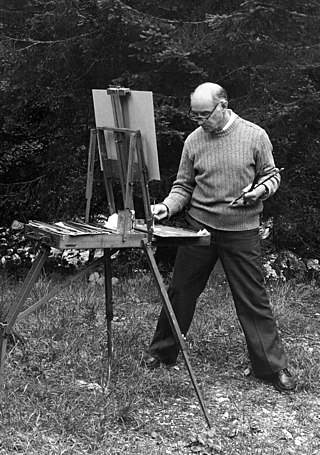
Abstract Impressionism is an art movement that originated in New York City, in the 1940s. It involves the painting of a subject such as real-life scenes, objects, or people (portraits) in an Impressionist-style, but with an emphasis on varying measures of abstraction. The paintings are often painted en plein air, an artistic style involving painting outside with the landscape directly in front of the artist. The movement works delicately between the lines of pure abstraction and the allowance of an impression of reality in the painting.

Visual art of the United States or American art is visual art made in the United States or by U.S. artists. Before colonization, there were many flourishing traditions of Native American art, and where the Spanish colonized Spanish Colonial architecture and the accompanying styles in other media were quickly in place. Early colonial art on the East Coast initially relied on artists from Europe, with John White the earliest example. In the late 18th and early 19th centuries, artists primarily painted portraits, and some landscapes in a style based mainly on English painting. Furniture-makers imitating English styles and similar craftsmen were also established in the major cities, but in the English colonies, locally made pottery remained resolutely utilitarian until the 19th century, with fancy products imported.
Action painting, sometimes called "gestural abstraction", is a style of painting in which paint is spontaneously dribbled, splashed or smeared onto the canvas, rather than being carefully applied. The resulting work often emphasizes the physical act of painting itself as an essential aspect of the finished work or concern of its artist.

Willem de Kooning was a Dutch-American abstract expressionist artist. He was born in Rotterdam and moved to the United States in 1926, becoming an American citizen in 1962. In 1943, he married painter Elaine Fried.

Lenore "Lee" Krasner was an American Abstract Expressionist painter and visual artist active primarily in New York. She received her early academic training at the Women's Art School of Cooper Union, and the National Academy of Design from 1928 to 1932. Krasner's exposure to Post-Impressionism at the newly opened Museum of Modern Art in 1929 led to a sustained interest in modern art. In 1937, she enrolled in classes taught by Hans Hofmann, which led her to integrate influences of Cubism into her paintings. During the Great Depression, Krasner joined the Works Progress Administration's Federal Art Project, transitioning to war propaganda artworks during the War Services era.

Franz Kline was an American painter. He is associated with the Abstract Expressionist movement of the 1940s and 1950s. Kline, along with other action painters like Jackson Pollock, Willem de Kooning, Robert Motherwell, John Ferren, and Lee Krasner, as well as local poets, dancers, and musicians came to be known as the informal group, the New York School. Although he explored the same innovations to painting as the other artists in this group, Kline's work is distinct in itself and has been revered since the 1950s.
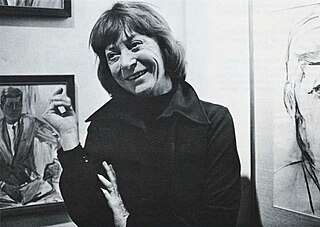
Elaine Marie Catherine de Kooning was an Abstract Expressionist and Figurative Expressionist painter in the post-World War II era. She wrote extensively on the art of the period and was an editorial associate for Art News magazine.
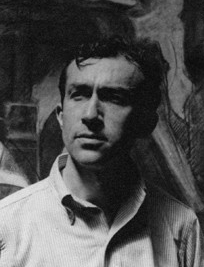
Hyman Bloom was a Latvian-born American painter. His work was influenced by his Jewish heritage and Eastern religions as well as by artists including Altdorfer, Grünewald, Caravaggio, Rembrandt, Blake, Bresdin, Ensor and Soutine. He first came to prominence when his work was included in the 1942 Museum of Modern Art exhibition "Americans 1942 -- 18 Artists from 9 States". MoMA purchased 2 paintings from the exhibition and Time magazine singled him out as a "striking discovery" in their exhibition review.

Joan Mitchell was an American artist who worked primarily in painting and printmaking, and also used pastel and made other works on paper. She was an active participant in the New York School of artists in the 1950s. A native of Chicago, she is associated with the American abstract expressionist movement, even though she lived in France for much of her career.
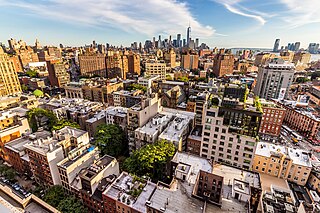
The 9th Street Art Exhibition of Paintings and Sculpture is the official title artist Franz Kline hand-lettered onto the poster he designed for the Ninth Street Show. Now considered historic, the artist-led exhibition marked the formal debut of Abstract Expressionism, and the first American art movement with international influence. The School of Paris, long the headquarters of the global art market, typically launched new movements, so there was both financial and cultural fall-out when all the excitement was suddenly emanating from New York. The post-war New York avant-garde, artists like Willem de Kooning and Jackson Pollock, would soon become "art stars," commanding large sums and international attention. The Ninth Street Show marked their "stepping-out," and that of nearly 75 other artists, including Harry Jackson, Helen Frankenthaler, Joan Mitchell, Grace Hartigan, Robert De Niro Sr., John Ferren, Philip Guston, Elaine de Kooning, Lee Krasner, Franz Kline, Ad Reinhardt, David Smith, Milton Resnick, Joop Sanders, Robert Motherwell, Barnett Newman, Michael Goldberg and many others who were then mostly unknown to an art establishment that ignored experimental art without a ready market.
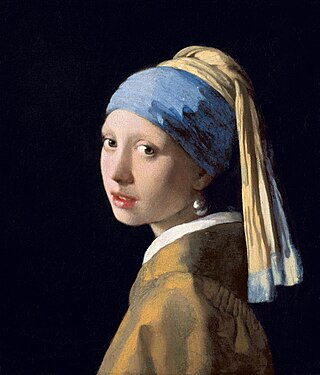
The history of Western painting represents a continuous, though disrupted, tradition from antiquity until the present time. Until the mid-19th century it was primarily concerned with representational and Classical modes of production, after which time more modern, abstract and conceptual forms gained favor.

New York Figurative Expressionism is a visual arts movement and a branch of American Figurative Expressionism. Though the movement dates to the 1930s, it was not formally classified as "figurative expressionism" until the term arose as a counter-distinction to the New York–based postwar movement known as Abstract Expressionism.

20th-century Western painting begins with the heritage of late-19th-century painters Vincent van Gogh, Paul Cézanne, Paul Gauguin, Georges Seurat, Henri de Toulouse-Lautrec, and others who were essential for the development of modern art. At the beginning of the 20th century, Henri Matisse and several other young artists including the pre-cubist Georges Braque, André Derain, Raoul Dufy and Maurice de Vlaminck, revolutionized the Paris art world with "wild", multi-colored, expressive landscapes and figure paintings that the critics called Fauvism. Matisse's second version of The Dance signified a key point in his career and in the development of modern painting. It reflected Matisse's incipient fascination with primitive art: the intense warm color of the figures against the cool blue-green background and the rhythmical succession of the dancing nudes convey the feelings of emotional liberation and hedonism.

American Figurative Expressionism is a 20th-century visual art style or movement that first took hold in Boston, and later spread throughout the United States. Critics dating back to the origins of Expressionism have often found it hard to define. One description, however, classifies it as a Humanist philosophy, since it is human-centered and rationalist. Its formal approach to the handling of paint and space is often considered a defining feature, too, as is its radical, rather than reactionary, commitment to the figure.

Mary Lee Abbott was an American artist, known as a member of the New York School of abstract expressionists in the late 1940s and 1950s. Her abstract and figurative work were also influenced by her time spent in Saint Croix and Haiti, where she lived off and on throughout the 1950s.
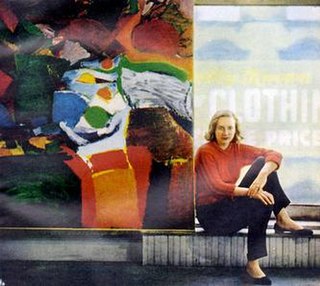
Grace Hartigan was an American Abstract Expressionist painter and a significant member of the vibrant New York School of the 1950s and 1960s. Her circle of friends, who frequently inspired one another in their artistic endeavors, included Jackson Pollock, Larry Rivers, Helen Frankenthaler, Willem and Elaine de Kooning and Frank O'Hara. Her paintings are held by numerous major institutions, including the Museum of Modern Art in New York City. As director of the Maryland Institute College of Art's Hoffberger School of Painting, she influenced numerous young artists.
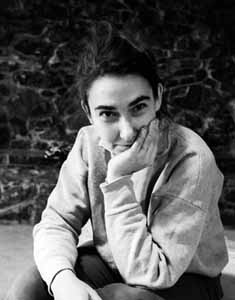
Pat Passlof was an American abstract expressionist painter.
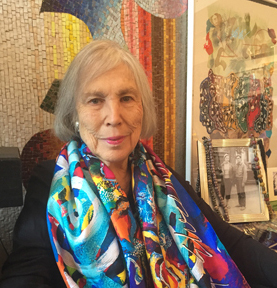
Amaranth Roslyn Ehrenhalt was an American painter, sculptor, and writer, who spent the majority of her career living and working in Paris, France before returning to New York City.


















